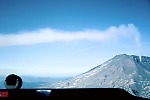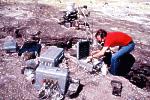Monitoring: | Gas | Ground Deformation | Hydrologic | Remote Sensing | Seismicity |
![]()
![]()
![]()
![]()
Monitoring: | Gas
| Ground
Deformation
| Hydrologic
| Remote
Sensing
| Seismicity |
![]()
|
At Mount Pinatubo, Philippines, steam-driven explosions (top) and emissions of sulfur dioxide gas preceded large magmatic explosive eruptions (bottom) in 1991. Details |
Scientists have long recognized that gases dissolved in magma provide the driving force of volcanic eruptions, but only recently have new techniques permitted routine measurement of different types of volcanic gases released into the atmosphere. Sulfurous volcanic gas and visible steam are usually the first things people notice when they visit an active volcano. A number of other gases also escape sight unseen into the atmosphere through hot fumaroles, active vents, and porous ground surfaces. The gases escape as magma rises toward the surface, when it erupts, and even as it cools and crystallizes below ground. A primary objective in gas monitoring is to determine changes in the release of certain gases from a volcano, chiefly carbon dioxide and sulfur dioxide. Such changes can be used with other monitoring information to provide eruption warnings and to improve our understanding of how volcanoes work. In recent years, we have directed increased attention toward volcanic gas emissions because of the newly appreciated hazards they sometimes pose and their effects on the Earth's atmosphere and climate. |
Gases released by most volcanoes are difficult to sample and measure on a regular basis, especially when a volcano becomes restless. Direct sampling of gas requires that scientists visit a hot fumarole or an active vent, usually high on a volcano's flank or within its summit crater. At some volcanoes, gases discharge directly into crater lakes. The remote location of these sampling sites, intense and often hazardous fumes, frequent bad weather, and the potential for sudden eruptions can make regular gas sampling sometimes impossible and dangerous.
Measuring gases remotely is possible but requires ideal weather and the availability of suitable aircraft or a network of roads around a volcano. Consistent and favorable wind conditions are needed to carry gases from vents and fissures to where they can be measured. In some cases, automated on-site gas monitoring is feasible. Under corrosive conditions, only a few sensors are available, however, for continuously recording the concentrations of specific gases.
Scientists face yet another challenge--acid gases, like SO2, easily dissolve in water. Thus, volcanoes with abundant surface or subsurface water can prevent scientists from measuring the emission of acid gases as magma rises toward the surface and even after explosive eruptions. Because CO2 is is less likely to be masked by the presence of water, measuring it when a volcano first becomes restless and between eruptions may be important for determining whether significant magma degassing is occurring.
In recent years, scientists have made significant progress in monitoring and interpreting the significance of volcanic gas release. Depending on several factors, including a volcano's eruptive history and potential hazards, the location and character of its fumaroles and active vents, and availability of monitoring resources and expertise, one or more of the following methods might be used to study gases escaping from magma beneath a volcano:
 |
The rate at which a volcano releases gases into the atmosphere (usually reported in metric tonnes per day) is related to the volume of magma within its magma-reservoir system and its hydrothermal system. By measuring changes in the emission rate of certain key gases, especially sulfur dioxide and carbon dioxide, scientists can infer changes that may be occurring in a volcano's magma reservoir and hydrothermal system. The emission rates of sulfur dioxide and carbon dioxide are measured using airborne or ground-based techniques. During large explosive eruptions, sulfur dioxide gas injected high into the atmosphere is measured by an instrument aboard a satellite. Details. |
Direct gas sampling with laboratory analysis
 |
Direct sampling of gases escaping from fumaroles is currently the only way: (1) to fully characterize the composition of gases discharging from volcanoes; and (2) to collect data needed to determine the origin of specific gases. Unfortunately, direct gas sampling does not provide information about the emission rates of different gases. The most common method for sampling volcanic gases is to collect them directly from fumaroles in solution-filled bottles, and then to analyze the mixtures in the laboratory. In this photograph, gases are drawn through a metal tube inserted into a fumarole at Mageik Volcano in Alaska; the sample was later analyzed at a USGS laboratory in Menlo Park, California. Details. |
Continuous on-site gas monitoring
 |
Continuous automated gas measurements can be made on a volcano directly in fumaroles, in the air near active fumaroles, and in the soil. At each gas measurement site, one or more chemical sensors measure the concentration of a specific volcanic gas, such as sulfur dioxide or carbon dioxide, and these data are transmitted by radio to a volcano observatory. These sensors can provide a real-time record of changes in gas concentration that may occur on a time scale as short as a few minutes. This site is located on the rim of Halemaumau crater in the summit caldera of Kilauea Volcano, Hawai`i. Details |
 |
Soil-efflux measurements can be made in areas where volcanic gases, typically carbon dioxide, rise from depth and discharge into the upper soil layers near the surface. Dozens of measurements are needed to map areas of high gas concentration. In this photograph, scientists are measuring the concentration of carbon dioxide gas in the soil at a site near Horseshoe Lake at the base of Mammoth Mountain volcano in California. Details |
Doukas, M.P., and Gerlach, T.M., 1995, Sulfur dioxide scrubbing during the 1992 eruptions of Crater Peak, Mount Spurr Volcano, Alaska: in Keith, T.E., ed., The 1992 eruptions of Crater Peak Vent, Mount Spurr Volcano, Alaska: U.S. Geological Survey Bulletin 2139, p. 47-57.
| Home |
U.S. volcano activity | World volcano activity |
Photo glossary |
Highlights |
| Search this site |
Site index |
Volcano observatories |
Educator's page |